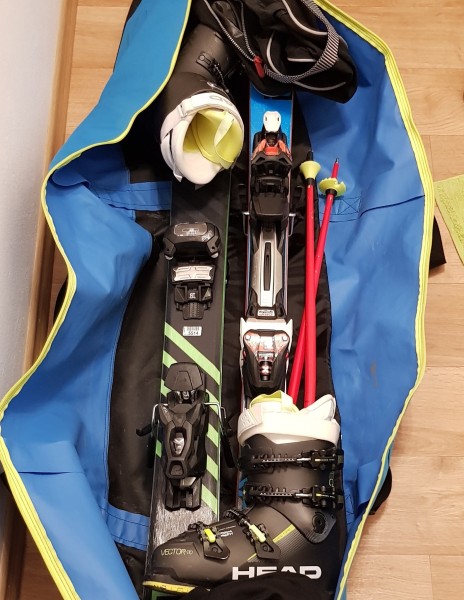Car and train are not always the best and only options for travelling to a ski holiday. For very long journeys, travelling by plane is often not only quicker, but also more relaxed. Transporting skis is also not as complicated as many might think. Several airlines even carry them free of charge.
We have summarised everything you need to know about travelling by plane, including all the information about packing and checking in ski and snowboard equipment.
Packing well needs to be learnt
Before you go to the airport, you first have to pack your luggage. Your winter sports equipment should also be packed properly and cleverly, as this can save a lot of weight. Skis, snowboards, ski and snowboard boots and poles should be padded in such a way that they can withstand the rather rough handling of airport staff. We recommend using bubble wrap, crumpled up newspapers or, if the airline allows it, soft and easily foldable clothing items such as underwear or socks.
Tips for packing
The tips of the ski poles should also be padded so that they protect the skis and the bag. To save weight in your standard luggage, it is useful to put some clothing or small items, such as sunglasses or ski goggles, in your ski boots. For safety reasons, the helmet should be carried in or on your hand luggage. This holds micro-cracks away from the helmet, which could make it unusable. Last but not least, a fragile sticker or other symbols should be attached to remind the ground staff to handle the bag with care.
By the way: In our shop you will find bags for skis, ski boots, ski poles and other types
General requirements
There are no general rules for travelling with winter sports equipment that apply worldwide. Each airline has different prices and size requirements for the different types of sports equipment. For most airlines, the equipment must not weigh more than 32 kilograms and is not allowed to include more than two bags of luggage. Many airlines generally charge an additional fee. Some only charge a fee if the number of pieces of luggage per passenger or the weight is exceeded.
Not all ski baggage is the same
The definition of ski or snowboard equipment can also vary. Some airlines only accept the sports equipment with appropriate footwear as equipment. Most airlines accept skis or snowboards with the appropriate boots and ski poles as one piece of equipment. Not many also admit a helmet as part of the equipment. Backpacks with avalanche airbags are considered dangerous goods and can be carried under certain conditions. You should always check with the airline before booking whether and to what extent they can be carried.
Watch out when booking
Once the suitcase is packed and the skis are stowed away, you can now turn your full attention to the booking. There are a few things to look for. At a few airlines, the sports equipment must already be specified when booking the flight ticket and subsequent bookings are not possible. If a subsequent booking is possible, it is still better to make the booking when purchasing the flight ticket. It is mostly cheaper this way. Depending on the rate of your flight, this can also be free of charge.
Caution when rebooking
If you are now in the situation where you have to make an additional booking, with most airlines this is only possible up to 24 hours before departure. In very rare exceptional cases, you can also book your ski equipment at the check-in counter. In general, the cargo space on the aircraft is limited.
This means that if you do not register your additional luggage in time, it may no longer be possible to take it on board. You should also watch out for the maximum sizes of the respective airline. Sports baggage can otherwise be declared as bulky baggage, which costs a little more.
It is common that the sports baggage must not weigh more than 32 kilograms. From a weight of 32 kilograms, the piece of luggage is considered excess baggage and additional fees will become due.
The day of departure

Even before you set off for the airport, you should think about how you will get to it. Travelling with suitcases and ski equipment needs to be planned. If you are travelling to the airport by car, simply pack your luggage in the car the day before departure. That way you won't realise on the day of departure that your suitcases and ski equipment don't fit in the car. If you take a taxi, it is important to specify the number and size of the items of luggage as precisely as possible to avoid any bad surprises.
At the terminal
When you arrive at the airport, the first stop is the check-in desk. To avoid any problems, you can confirm that you are taking your equipment with you. And if the additional booking is not deposited, there is a contact person at the check-in desk who can solve the problem. Once everything has worked out, the sports baggage usually goes to the baggage drop-off for special-sized baggage.
At your destination

If you have arrived at your destination airport and you are waiting vainly for your ski equipment on the baggage carousel, don't be alarmed. At many airports, the additional baggage comes from a different baggage carousel. The information desk at the respective airport can help you here. You can inform yourself in advance about what is common practice at your destination airport.
Departure for your accommodation
You should also take care of transport to your accommodation before you start your journey. You can order a taxi in advance, but you should also specify the size and type of your luggage. Alternatively, many hotels offer a shuttle service that is prepared for guests with ski equipment.
Costs per airline for ski baggage
Lufthansa
With Lufthansa it is possible to take skis as part of your free baggage allowance. However, there is only a limited amount of storage space for sports equipment per flight. In addition, registration is only necessary up to 24 hours before departure. The equipment is always handed in at the bulky baggage counters and can be handed in up to one hour before the scheduled departure.
One ski or snowboard equipment per passenger is included free of charge, if it does not exceed the weight limits for the class booked. In Economy Class this is usually 23 kilograms and in Business Class up to 32 kilograms. The only exceptions where the above conditions do not apply are flights to or from the USA, Mexico and Central America, as well as the Economy Class Light rate.
Austrian Airlines
Austrian Airlines offers free carriage of one ski or snowboard equipment per passenger. Here, the limit of 32 kilograms and two pieces of baggage may not be exceeded, too. Only European routes in the light fare and routes to or from the USA are excluded.
For equipment that is longer than 200cm, contains more than two pieces of luggage or weighs more than 32kg, carriage within Europe costs 80 euros. Flights to the Near or Middle East cost 100 euros. For a medium intercontinental route you pay 200 euros and a long intercontinental route costs 250 euros per passenger.
Swiss Airlines
One Ski or snowboard equipment is also free of charge with Swiss Airlines, provided that the maximum dimensions of 200cm in length, a weight of 32kg and two pieces of baggage are not exceeded. It must also not be a "codeshare flight", a flight in the Economy Light rate or a flight to or from the USA. If one of the requirements is exceeded or if it is one of the above-mentioned flights, transport within Europe costs 80 euros. Intercontinental prices vary depending on the destination.
Equipment on Swiss Airlines is defined as a pair of skis or a snowboard, a pair of ski or snowboard boots, a helmet and ski poles. It is not mandatory to register the additional baggage in advance, but it should be done, otherwise carriage cannot be guaranteed.
Ryanair
With Ryanair, the transport of equipment weighing less than 20 kilograms costs a total of 45 euros for outward and return flight. Flight-specific rates apply for ski equipment weighing over 20 kilograms. The most favourable prices can be obtained directly when booking the ticket. More expensive fares usually apply for equipment added to the booking later or at the airport.
Eurowings
It is possible to book ski and snowboard equipment with Eurowings until the web check-in closes before departure. But only as long as storage space is available. Equipment includes skis with poles and boots or a snowboard with appropriate boots. These should weigh a maximum of 32 kilograms and be split between two pieces of luggage. Prices start at 30 euros and vary depending on the flight route.



